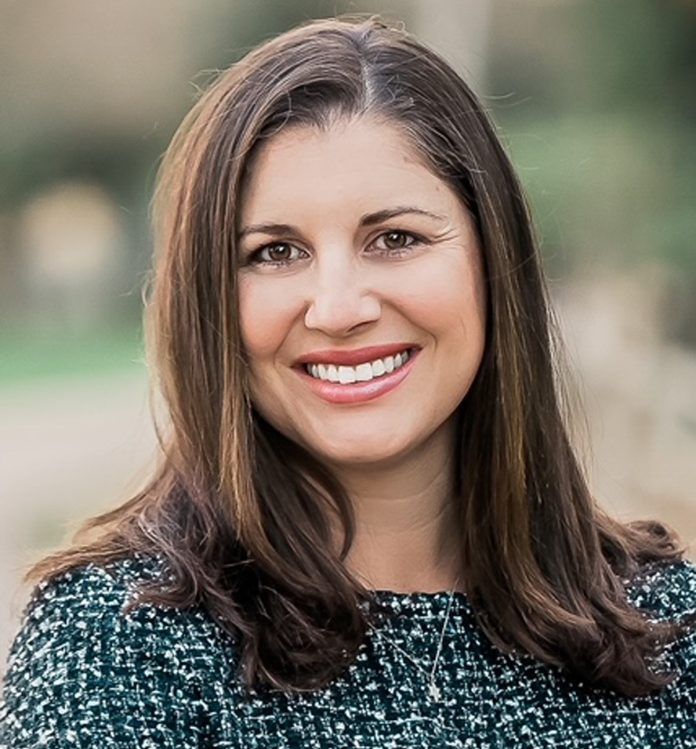Gina Jacobs is running for District 2 San Diego County Supervisor against incumbent Supervisor Joel Anderson. Jacobs, D, 42, was born and raised in San Diego, growing up in University Heights. Her father is a small business owner, and her mother worked for the Department of the Navy. She attended SDSU for her bachelor’s in communications and earned her MBA at Allian International University in Sustainability. Jacobs said she has spent the past 10 years working in public service. For almost seven years, Jacobs worked for the Airport Authority and has worked for the Port of San Diego for two years as a Diversity, Equity and Inclusion Manager. Jacobs lives in Del Cerro.
“I have been volunteering in my community as long as I can remember. Things my family has been very active in. My dad is a Vietnam veteran, and I used to go with him to Stand Down in Balboa Park where he would volunteer offering his services to the veterans,” she said.
Jacobs said her professional background is a blend of program management, business operations, and small businesses.
“With my dad owning a small business, I understand the challenges that small businesses encounter in the marketplace. I have spent a big part of my career dedicated in looking at those challenges and what are the barriers small business owners experience in contracting with government entities, large corporations, and worked collectively to reduce those barriers,” she said.
Jacobs oversees the small business program at the Port, and equal opportunity employment in contracting.
“I handle contracting in the small business side and equal opportunity options on the workforce side. Seeing that everybody has equal opportunities to resources and the things they need to be successful in their organization, as well as the Port’s five member cities,” she said.
Jacobs said she has a love for public service, and it comes naturally for her to want to help her communities.
“The reason I decided to run for office is that District 2 has about 690,000 people, and there are unincorporated areas, incorporated areas. You have the city of San Diego which is about 50% of the electorate. Then you have Poway, El Cajon, Lakeside, Santee and many other smaller communities throughout the district. I realized that most people there are like me. They are working professionals, parents, wanting to make sure they have a good life here in San Diego with the high cost of living, all our transportation issues, homelessness. I decided to run to represent those like me and to make sure collectively we have a voice at the county level. And, that we can gain access to that $1 billion county budget and to ensure we get our fair share of those resources,” she said.
Jacobs said though she lives in Del Cerro, her family owned a cabin in Pine Valley and grew up with her dad camping and traversing the entirety of District 2 in the backcountry and rural areas, and hiking on all the trails.
“I am passionate about protecting our open spaces in East County. The Cleveland National Forest is beautiful. Even though I do not live in the unincorporated and rural areas in the district, I am very familiar with those communities with my family’s property out there,” she said.
Jacobs said one of her priorities is housing/homelessness issues.
“We have the largest population of unhoused in District 2. On the homelessness side and also the rising costs of housing, it is pushing people further out because it is where reasonable housing exists. We get secondary issues because of that such as massive congestion on all the highways and throughfares that go from East County to central cities where people work. The other large issue in District 2 is fire safety and the rising costs and availability of homeowner insurance. Wildfires are becoming more common and more destructive in East County. With recent legislation coming down from the state level, it is hard to get insurance for your house,” she said.
Jacobs said her third priority is the fentanyl drug crisis.
“It is happening all over, but there are pockets in East County that have gotten out of control,” she said, adding she has a friend in El Cajon who talks about homeless individuals openly using drugs in the streets. “That is a huge issue from a public safety standpoint, and something that we need to focus on. We need to find financing for programs that have been successful from the county in the east areas to address that. It is a much bigger problem, but we can tackle pieces of it to make it better for the residents here.”
Jacobs said the migrant crisis has been a challenge for East County because it has several communities on the border.
“The Border Patrol’s air facilities in Jamul, Jacumba, it was a big burden on the community. The communities rose to the occasion, but I do not feel like that should have had to do that. Customs and Border Patrol did not have the resources to cross these individuals. They did not have food, restroom facilities, or shelter to shield them from the elements. They did not have what they needed from the federal government to be effective and manage the situation in a humane way. These communities did not expect to have these open-air popup facilities there. But what I did see that warmed my heart is that these communities that had to deal with this migrant crisis, they rose to the occasion, did donation drives, and stepped in to help,” she said.
Jacobs said on the county side, there needs to be a closer collaboration with the federal government and the Center for Domestic Preparedness to ensure there are resources to set up this type of operation, planned for in advance, and not a reactive response.
“Financially also. There must be a way to find funds to help process these individuals locally,” she said. “The migrant problem still exists. It did not go away. It is just not getting as much coverage now. They are still processing people in East County right now.”
With refugees, Jacobs said initially they were put in temporary housing, but eventually wound up in El Cajon because of the cost of housing, and it is a stronger city that is welcoming of them coming in.
“It is still challenging. We stay in contact with families that we sponsored and helped through that process. Again, there was not that collaboration with our county. The people came, it was sudden, and the resources were not set up to receive them appropriately, to connect hem to the things they needed to be successful and sustain living in San Diego with the high cost of living here,” she said.
Jacobs said it is still difficult getting them jobs even though they were working professionals in Afghanistan, for example. They must start all over once they get here, she said.
“I think the county did what they could with the craziness of the situation. I think they could have done better to spread out the refugee population throughout the county instead of such a high-density in the eastern parts. They did not even have translators for the three major languages spoken in Afghanistan,” she said. “They really did not have the resources from the federal level that they needed.”
Jacobs said she has mixed feelings about the push for the use of local public transit and affordable housing being built around transit centers. She said she could theoretically take public transit from her home to the Port.
“The reality of that is that it would take me an hour to get there. I also have a child that I must get to school, activities. I would love to utilize public transit, but the infrastructure is not set up for mass utilization right now. If you have the infrastructure for mass transit with affordable housing where it makes it easy for people to get to their jobs, their kids to school, then yes, that is the ideal scenario. Our city was not made with that in mind like other cities. We are mostly commuter cities. In theory, it is a good idea, but in practice, I do not know how it would work. It might make more sense to do high-density affordable housing in areas that are in a reasonable commute of people’s work and other life activities. The county has a lot of land and real estate assets which could be potentially converted into affordable housing. It is cost prohibitive for builders to build affordable housing in much of East County due to the lack of transit, wildfires, and the other challenges this region faces,” she said, adding that the county needs to look long-term in addressing the efficiency of the public transit system.
Jacobs said the majority of residents in District 2 she has spoken with are not clear on what the county does or provides.
“They do not know that the county has the Sheriff’s department, CalFire, the libraries, health and human services. They are just not aware of what the county does every day and provides them as a resident in paying their taxes. There needs to be a lot of education in the community about who and what the county government does. Then secondary, how they can easily connect to resources. For example, if you meet someone who is unhoused, if you call the county’s homeless hotline, there are a bunch of prompts, eventually with you having to leave a message. Having that personal touch to guide them through that process,” she said, adding that it takes to long to get to the resources that you need. “I think there is an opportunity to explore different community channels to reach a broader audience.”
Jacobs said she agrees that there should be a community park in Alpine for the residents and families that live there.
“I think there should be a baseball field because those families right now must commute pretty good distances for their kids to participate in recreation and activity sports. I do not know in all honesty if it needs to be at the scale, it is right now. I was not involved in the community meetings. I have watched the videos and heard from community members. I think that there is the opportunity to have the essence of what that park would look like without the enormity of it all, and I would like to see what really the needs of the community are. Right now, there are pickleball courts, baseball fields, basketball courts. It has a community garden and a dog park, which I think is awesome. There are a lot of things that I want to know from the community. If we build it, will it be utilized. Or will it just be a $44 million park in a space that people use occasionally,” she said. “I always support multi-use recreation and open spaces. That is the way you build community. There is a great county park in Pine Valley. It does not have a baseball field and all these other things, but it is a nice county park. I want to work with the residents on a needs assessment and find out what is best for the residents. You cannot please everybody, but you can work together with the people to make sure needs are being met with recreation, open space, sports, and balancing it with people who want to maintain open space, and what is the negative impact on wildlife and native plant species. From what I understand from the community is that the county went in with this small-scale park, but when it came for a vote, it was much more than what they explained.














